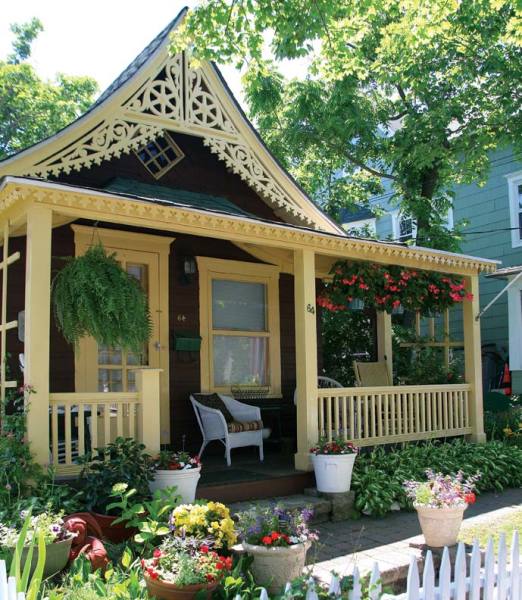
The decorated gable on this little Victorian charmer is typical of Ocean Grove.
Architecturally speaking, Ocean Grove, New Jersey, is to the northern part of the state what Victorian Cape May is to the south—and maybe then some.
Ocean Grove houses, large and small, flaunt spectacularly lighthearted Victorian Stick Style ornament. On multistory porches and front-facing gables, an explosion of jigsawn and lathe-turned wooden decoration creates a celebratory display that makes every day in Ocean Grove seem like the Fourth of July. Buildings are painted in the natural hues preferred by Victorian-era tastemakers—subdued earth tones, darkish greens and blues, and, of course, the ever-popular seaside white or ivory. The colors are enhanced by residents’ penchant for blooming vines, shrubs, and trees.
Even without the Victorian frippery, the little resort town has all the usual ingredients of a great seaside getaway—ocean views, sandy beach and tranquil boardwalk, landscaped parks, and close-by lakes, plus attractive shops and restaurants and a slew of special events—more than enough to keep a body busy. But for old-house aficionados, Ocean Grove has much more to love.
From Bare to Rare
The architecture wasn’t always so showy, of course. In 1869, the unspoiled rustic setting caught the eye of William E. Osborne, an evangelist looking for an oceanfront camp meeting site where Methodist families could seek spiritual and physical renewal far from the distractions of urban life. Although much has changed since that time, Methodists from communities across the eastern United States still flock to Ocean Grove for the same reasons. The town’s signature aggregation of canvas tents encircling the massive 1894 Stick Style edifice known as the Great Auditorium still stands at the heart of the community.
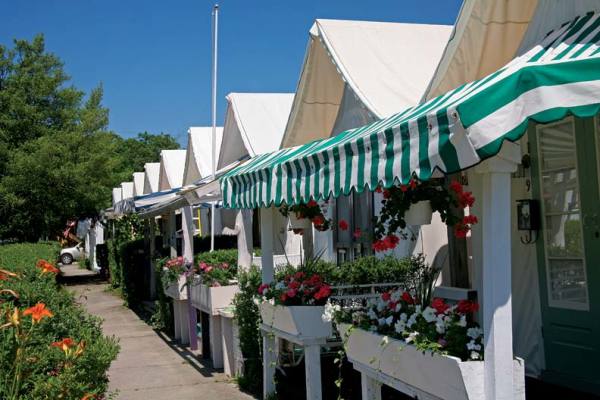
Ocean Grove’s unique canvas camp meeting tents are highly sought-after living spaces.
The original summer tent settlement soon grew to include small frame kitchens behind the tents and wooden “sitting” porches in front of them. In 1875, commuter rail service to New York and Newark replaced arduous trips to the beach by wagon or boat, the summer population boomed, and the tents were quickly supplemented (though never entirely replaced) with simple frame cottages, then larger cottages and private houses, boarding houses, and hotels.
Well-conceived from its beginning, Ocean Grove has now earned a place in the National Register of Historic Places as a distinctive, planned 19th-century development; it is also a New Jersey landmark. In addition to an unusually adaptive street layout, it is amply equipped with small parks and walking paths, including the Ladies’ Walk and the Gentlemen’s Walk. In an admirable show of seashore manners, houses in the two blocks nearest the ocean were built with progressively deeper setbacks so that each house has a view of the beach.
What’s a Stick Style House?
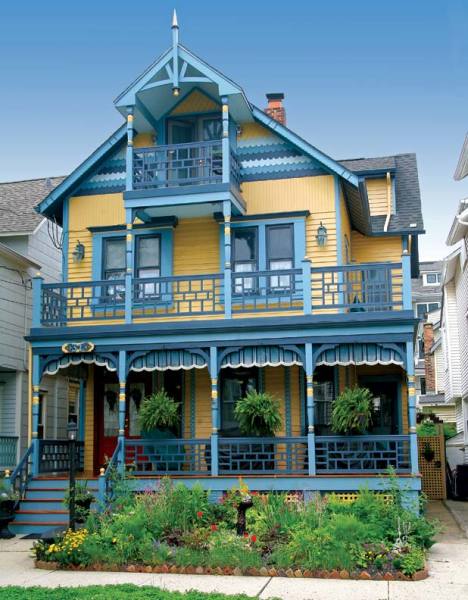
A third-story balcony perches above the main porch on a classic Stick Style house.
Stick Style is a descriptive term that arose in the mid-20th century to describe houses built a hundred years earlier. It is generally credited to architectural historian Vincent Scully in his 1973 book The Shingle Style and the Stick Style.
Informal frame houses of the 1870s, ’80s, and ’90s, like the ones that predominate in Ocean Grove, were often called “Seaside Houses or Cottages” by Victorian planbook publishers such as the Palliser Brothers, because they were especially popular in coastal locations. These houses were often enlivened by linear (i.e., stick-like) wooden ornament applied vertically or horizontally to the exterior walls to suggest post-and-beam construction. But the term also includes the kind of frilly millwork that delights the eye on many late-Victorian porches, gables, and dormers.
For the most part, Stick Style features are decorative, not functional. They are often applied, as in Ocean Grove, to very basic rectangular, L-, or T-shaped houses. The most important—and most frequent—exception to this rule is found in the kind of prominent gables and integral porches that abound in Ocean Grove. Here, the vertical and horizontal elements, and sometimes even lavishly ornamented arches and angles, also serve a structural purpose, because porches and gables included under the main roof are integral parts of the structure, not separate additions that can be removed and replaced at will.
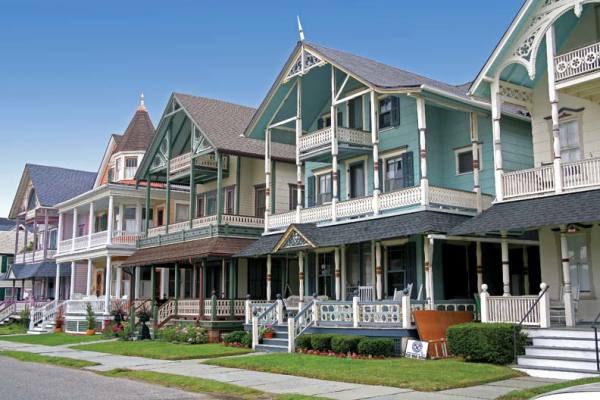
This line of large houses recalls seaside designs in Palliser & Palliser pattern books.
The ornament on Ocean Grove’s houses is so varied and fanciful that you may have to look closely to notice that the buildings themselves, though often large (three stories is a common height), are pretty much plain Jane. But even tiny one-story cottages wear their finest wooden jewelry on their street façades, and larger buildings are truly objects of wonder. Much of the millwork echoes the exuberant gingerbread found in the work of popular late 19th-century planbook designers.
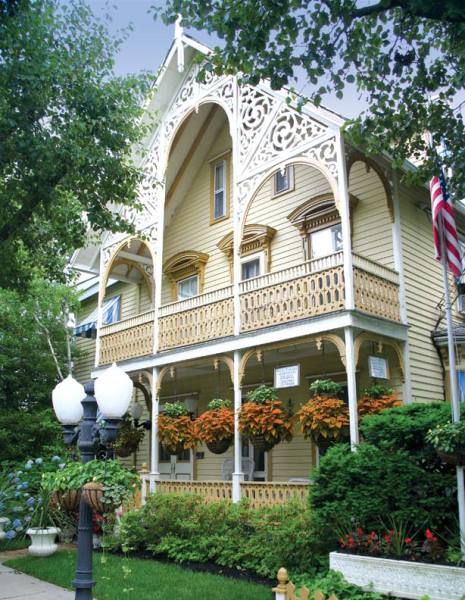
One of Ocean Grove’s most exuberant examples of Victorian embellishment.
Nature and technology conspired in the post-Civil War decades to make America’s booming housing industry the most blatantly decorative and intensely wood-based in the nation’s history, particularly in towns not driven to masonry construction by the (well-justified) fire phobia of urban areas. Formerly untapped forest reserves provided abundant wood, modern mills and machinery such as jigsaws and lathes turned that wood into houses and ornament, and mail-order planbooks suggested what and how to build.
Turned posts, molded handrails, and substantial but unadorned braces are merely supporting players for the real stars of the show here—dramatic cobwebs of turned wood, vertigo-inducing carved wheels, impossibly intricate brackets, lace-like jigsawn flat-work. Given the potential effects of wind and water on wood, some of the millwork may be recent replacements or repair jobs, but in a testament to solid stewardship on the part of owners, jarring missteps are hard to find. Easy to see why you don’t have to be a Methodist to love Ocean Grove.
Online Exclusive: Bone up on the lingo of Victorian ornamentation with our pictorial glossary.







